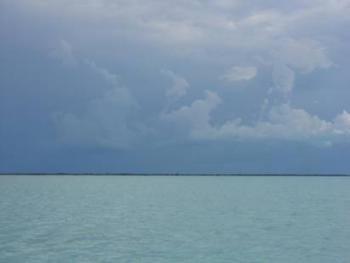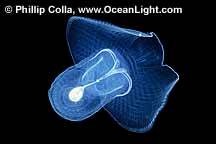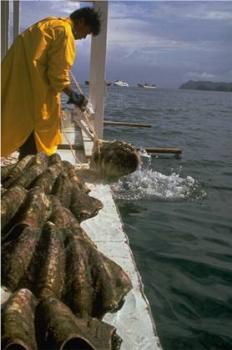Dropping pH in the Oceans Causing a Rising Tide of Alarm
Tundi Agardy, Ph.D.
One of the most unexpected consequences of global climate change may
well turn out to be one of the most severe in terms of impacts on life
on earth. As continued carbon emissions accelerate global warming, the
carbon dioxide contained in those emissions is able to silently yet
dramatically reduce the alkalinity of the oceans. And as the pH drops,
marine organisms that produce shells and carbonate skeletons grow weak
and die off.

The discovery that carbon dioxide emissions can lower global ocean pH is very recent, even though chemists and biologists have for long known that when carbon dioxide dissolves in water, carbonic acid results. However, the sheer volume of water in the oceans has always been assumed to be so vast as to be safe from changes in chemical balance brought about by small scale inputs. In effect, it is just plain hard to imagine that atmospheric inputs of any kind could significantly alter the chemical composition and nature of over 1.3 trillion cubic kilometers of ocean water. Thus when intrepid oceanographers and marine ecologists set out to address the question of how changing atmospheric conditions that lead to changes in pH could affect marine life, they raised alarms about the possibilities of very large scale impacts.
Like all significant and surprising scientific discoveries, many great minds may have simultaneously converged on the idea that loading up the atmosphere with carbon emissions would begin to affect the ocean environment, and in turn its ability to further sequester carbon and maintain environmental parameters in balance. The story of one such scientist playing a key role in uncovering the phenomenon of ocean acidification was Victoria Fabry. According to New Scientist magazine1, Fabry was doing shipboard experiments on small pteropod mollusks she kept in sealed jars, when she began to notice that their shells were dissolving. She surmised that the carbon dioxide respired by the pteropods was making the seawater more acidic and dissolving the calcium carbonate of their shells.
 The fate of the delicate pteropods in her jars made Fabry join other scientists in wondering whether increasing the carbon dioxide concentration of the atmosphere could have a similar effect on sea life in the oceans. There had already been publications and reports on the increasing acidification -- technically, decreasing alkalinity since seawater is has an average pH of more than 8.0, and the predicted drop in pH will not take seawater below the neutral pH of 7. Most notable was perhaps the 2003 Nature paper calculating that absorption of fossil CO2 would make the oceans more acidic than they had been in 300 million years2. But it was only in 2005, when the Royal Society of UK launched an investigation into the effects of acidification on marine life3, that significant attention was drawn to the consequences of this "other CO2 problem"4.
The fate of the delicate pteropods in her jars made Fabry join other scientists in wondering whether increasing the carbon dioxide concentration of the atmosphere could have a similar effect on sea life in the oceans. There had already been publications and reports on the increasing acidification -- technically, decreasing alkalinity since seawater is has an average pH of more than 8.0, and the predicted drop in pH will not take seawater below the neutral pH of 7. Most notable was perhaps the 2003 Nature paper calculating that absorption of fossil CO2 would make the oceans more acidic than they had been in 300 million years2. But it was only in 2005, when the Royal Society of UK launched an investigation into the effects of acidification on marine life3, that significant attention was drawn to the consequences of this "other CO2 problem"4.
The idea is not without controversy. Some scientists still cling to the idea that the buffering capacity of the oceans, by virtue of their sheer size, will counter any acidification effects. Others insist that carbonate inputs from dissolving rocks on land will counteract any reduction in alkalinity in the oceans. Still others argue that a feedback loop between oceans and atmosphere would dampen the effect; others argue that even a significantly lowered pH would not send any marine species to extinction and organisms would adapt to the changes. And even those who are most vocal about the possible effects of ocean acidification acknowledge the uncertainties, and the lack of in situ empirical proof that elevated carbon dioxide in the atmosphere lowers pH and causes significant ecological impact. However, two comprehensive, multi-institutional initiatives suggest that the scientific consensus rests squarely with those who predict major changes in ocean pH, and the potential for dire consequences for marine life as a result. The first is the report of the investigation carried out by the Royal Society of the UK, which notes both alarming conclusions from modeling and the lack of field evidence to either repudiate or bolster such models, but nonetheless makes a strong appeal for a precautionary approach. The second, in response to the Royal Society report, is the launching of the IGBP (International Geosphere Biosphere Program) - SCOR (Scientific Committee on Ocean Research) Fast Track Initiative on "Ocean Acidification".
The perceived scenario of major biodiversity losses as oceans lose their alkalinity goes like this: carbon dioxide levels double over their pre-industrial values by 2050. The rate of CO2 occurs on the order of 1.1 ppm/year, two orders of magnitude faster than even the relatively rapid rates seen during glacial - interglacial transitions.5 Atmospheric exchange with the surface waters of the ocean increases CO2 concentrations in the oceans, and carbonic acid is formed. Surface pH, having already dropped to an average pH of 8.14 from pH 8.25 since 17516, continues to decline in an accelerated fashion. Calcifiers living on or near the surface or in shallow coastal waters, such as coccolithophore plankton or corals, become unable to form carbonate structures, and some species die out7. At sea the phytoplankton community is altered, causing the pelagic marine food web to be disrupted. And inshore, coral reefs lose their reef-building capability, and the entire tropical food web that has reefs at its base shifts to a much less diverse, and possibly less productive, state8.


The impact on marine food webs has the possibility of affecting mankind in at least two dramatic ways. First, human populations relying on marine resources will have to adapt their practices to changing conditions, requiring shifts in target resources and fishing practices or other uses. For urban or suburban dwellers in the developing world, there is likely to be little immediate impact but for the loss of favored shellfish from the menu - but for rural dwellers in the developing world who rely on marine ecosystems for income, these changes may well be disastrous. Currently almost 40% of the global population lives near and depends on the oceans, and loss of biodiversity and damage to ecosystems will bear social and economic costs9.
The other effects may be more insidious and severe. Loss of coral reefs, for instance, mean not only changes to treasured ecosystems harboring vast amounts of biodiversity, but also the loss of ecosystem services that serve and protect human communities. Tourism and recreational use of tropical areas will decline as reefs are degraded, as carbonate sands formed by reef ecosystem processes dwindle, and as reefs become less diverse and monochromatic. But we are not talking only of ruining the vacation plans of wealthy tourists. Many coastal economies are wholly dependent on coastal tourism and marine resources. And coral reefs provide a major source of food for a large part of the global population, and they provide coastlines and communities important buffering from storms and tsunamis. If reefs stop growing and cannot keep pace with rising sea levels, these important ecosystem services will be lost.

The public has not responded to the possibility of large scale changes brought about by this ‘other CO2 problem', in part because although the issue has been picked up by the media, the significant uncertainties in terms of how much change will occur and how quickly have also been reported. Scientist investigation of this issue is in its infancy. Unlike studies on the effects of warming, where El Nino Southern Oscillation events allow researchers to monitor the real life consequences of rapid changes in water temperature, no equivalent natural phenomenon exists for drops in alkalinity. So most of what we know and must surmise comes from laboratory studies and modeling.
This is not to say that lab experiments and modeling are unimportant. But understanding the extremely complex dynamics of marine systems from the parsed and simplified worlds of the lab and computer is a challenge. And while we can gain important knowledge about how acidification can affect living organisms and ecosystems, we have to remember that these effects are occurring in the context of an ever-changing world.
Ah, were we only in the position to be able to evaluate ecological risks one at a time, and dismiss those that seemed uncertain. Science, and life, would be so much simpler! But changes in ocean pH are occurring along with large scale changes in temperature, in nutrient input, in levels of toxic pollution, and in abundance and distribution of organisms caused by extractive use. Coral reefs are but one kind of marine ecosystem already demonstrating the death of a thousand cuts phenomenon today - warming is causing widespread bleaching, eutrophication is spurring algal overgrowth, and overfishing is removing grazers that keep algae in check. Add to this morbid scene a significant drop in pH, and it is clear that the tipping point for corals cannot be very far away. Sadly, the fate of other marine ecosystems could follow a similar trajectory.
So it is not surprising that researchers and conservationists are ringing the alarm bells. Carol Turley, one of the authors of an Ospar report on ocean acidification, was quoted as saying "This issue is emerging as one of the most serious threats humanity has faced."10 The issue has caught the attention of even non-marine conservationists. Thomas E. Lovejoy, a world renowned tropical forest ecologist and President of the Heinz Center, said "When I first heard this information I really considered it one of the most chilling environmental briefings I have had".11 Chilling, in the face of warming, indeed.
Endnotes
1 Henderson, C. 2006. Paradise lost. New Scientist 5 August 2006 :29-33
2 Caleira, K. and M. Wickett. 2003. Anthropogenic carbon and ocean pH. Nature 425: 365
3 The report coming out of that study was published in 2005 and is titled: Ocean acidification due to increasing atmospheric carbon dioxide. The Royal Society Policy Document 12/05; available at www.royalsoc.ac.uk
4 The term "the other CO2 problem" was used in Henderson 2006 p 29; however it was also used in 2005 on the site RealScience in a posting called: The Acid Ocean: The Other problem with CO2 Emission http://www.realclimate.org/index.php?p=169
5 http://igbp-scor.pages.unibe.ch/index.html
6 Jacobson, M. Z., 2005. Studying ocean acidification with conservative, stable numerical schemes for nonequilibrium air-ocean exchange and ocean equilibrium chemistry. J. Geophys. Res. Atm., 110, D07302.
7 Kleypas, J.A. 2006. Predictions of climate change in the tropical oceans, and how that should shape our conservation efforts. Proc. World Maritime Technology Conf. 6-10 March 2006, London .
8 No one suggests that corals will die from the pH changes, but their ability to lay down skeletons is almost certain to be affected. It is thought that some coral species will be able to shift from aragonite production to calcite production, and thus still retain some of their calcification ability. However, while these shifts have been demonstrated in the lab, they occur under different conditions from those in which carbon dioxide is increased.
9 Millennium Ecosystem Assessment. 2005. Ecosystems and Human Well-being. Island Press, Washington DC - also available at www.maweb.org
10 National Parks and Protected Areas International Bulletin 21 May 2006 p 8
11 Crossroads: Newsletter of the H. John Heinz Center for Science, Economics, and the Environment 3(1) 2006 p 1. Lovejoy also said, in Juliet Eilperin's July 5, 2006 Washington Post article entitled "Growing acidity of oceans may kill corals" : "It's (ocean acidity) the single most profound environmental change I've learned about in my entire career."


